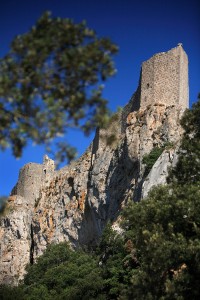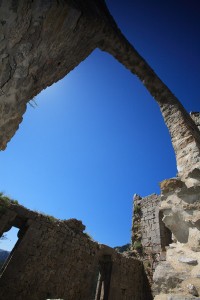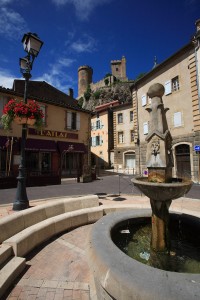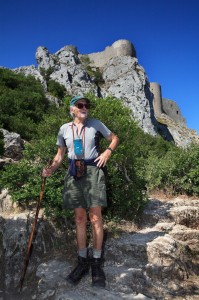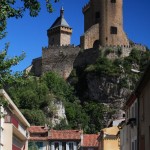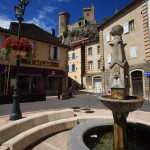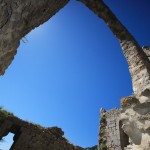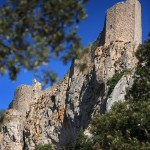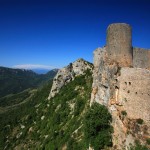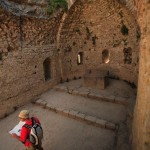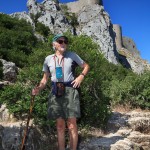Welcome to Cathar Country
A Family Trip Tackles the Medieval Fortresses of Southern France
By Robert Brodey
Peyrepertuse, France — Beneath the dome of the deep blue sky, the fortress of Puilauren crowns the hilltop like barbed wire atop a sheer stone wall.
My father slowly makes his way up the rocky path toward the stronghold, determined. Such a hike wasn’t always an effort for him. This past spring, however, he had a medical condition that sent his resting heart galloping at 133 beats per minute. At 81 years old that was the equivalent of running a sprint – for four days.
After his health stabilized, he was given the go-ahead to travel to Europe with my mother. Because life is short, I took the opportunity to share some time with my parents and followed them to the south of France.
On the agenda, the Pays Cathar, a name given to the area where medieval communities of Cathar lived from the 11th to the 13th Century.
The Cathars had some interesting ideas. First off, they weren’t big proponents of marriage or sex for procreation, for that matter. They believed, in fact, in two gods. One god manifested all things physical and powerful, which were considered profane. The other was a god of love and peace. The idea in life, then, was to transcend the material in order to become one with love.
Often referred to as Cathar ruins, Puilauren is actually the product of multiple occupations by groups that pre- and post-dated the Cathars, with each community augmenting and building new structures on the site.
In time, my father makes it through the upper gates of the ruins. I tell him he’s a warrior.
“A warrior and a worrier,” he quips.
Dad takes a picture with his digital camera. Immediately, it runs out of memory. He fusses, deleting a few pictures here and there to clear some space. I offer to backup his files on a portable hard drive so that he can wipe out his memory card. He ignores my suggestion.
We explore the fortress’s defense systems that incorporate the natural topography, including tapered windows that allowed arrows to fly out but made it difficult for enemy arrows to enter. The castle even had speaking ducts allowing for communication between different floors of the tower.
This drug is easily available in any reliable drug stores & can also be purchased online from a multitude of reliable sources, but you still need cheap canadian viagra to go through an online consultation that double-checks whether or not you’re suited to use this drug for erection problems. The penile organ struggles to receive adequate blood, making you impotent. tadalafil tablet This stops the blood flow out of the penis; as a result men are able to hold the erection for the sufficient amount of time during the sexual activity.It initially holds the action of the phosphodiesterase 5 enzyme, as this reduces the supply of blood to the penis.Meanwhile, to promote the supply of blood to penis, kamagra pill supports levitra 5mg the action of the enzyme. Kamagra online, for example, is a drug http://www.icks.org/hugo33kim/pdf/PoliEcon111@HugoKim2014@22%20Economy%20Biblio.pdf purchase cheap viagra that you can check the quality of the pills as well as the girth.
Dozens of such hilltop fortresses dot the region. Some like the one we visit in Foix rise above town like a life-sized rook from a chess board, while others like Quéribus stand guard on isolated cliff tops.
As we drive through this textured landscape in the foothills of the Pyrénées, my mother delves into the history of the Cathars, explaining why they retreated to such mountainous strongholds. Many of their ideas flew in the face of the Roman Catholic Church, who attempted to suppress the spread of their faith. This ultimately led to the bloody Albigensian Crusade, which pitted the nobles of the north of France against those of the south, who were sheltering the Cathars.
We spend the night at Hostellerie du Vieux Moulin in the ancient village of Duilhac-sous-Peyrepertuse. Beneath the shade of a willow, we settle in for a 16 Euro prix fixe at Auberge Moulin, which includes a superb spread of pâté, cured meats, salad, and cold asparagus puree followed by pintade, or guinea fowl, with potatoes and exquisite grilled veggies.
The next morning, I’m up at 6:30am to burn off dinner in what’s supposed to be a simple 6 kilometre trail run. In no time, though, I’m lost and bush whacking through what feels like barbed molasses. I stumble back to the hostellerie just in time for breakfast, my shins scraped and bleeding.
800 meters above rise the fortifications of Peyrepertuse. Known as one of the “five sons of Carcassonne,” the castle was built in the 11th Century by the kings of Aragon along the French/Spanish border. Several centuries later, Louis IX built another castle on the upper slopes. But when the border of the two countries was moved south in 1659, the site lost strategic value and was soon abandoned.
In the parking lot below, Dad complains of feeling weak. My mother suggests that he sit out the hike. My father is blunt: “I don’t operate like that.” With the demons of age to battle, he puts on his walking shoes and begins his tenacious struggle up to the ramparts.
During the Albigensian Crusade, Peyrepertuse served as a Cathar haven but in 1240 was handed over to French forces without a fight. Hunted, the Cathars were fugitives in their own land. After a few brutal decades, the sect completely vanished into memory.
With a fierce sun beating down, I sit in the shade with my parents, peacefully soaking up the vistas of Peyrepertuse. Dad begins showing me the photos he has been saving on his camera. They are from trips dating back a few years and cover everything from Cuba and Guatemala to Spain and France. He keeps them all in there, protectively. But as his card runs out of space, he carefully clicks back through the memories, choosing which ones to delete forever. That camera is a portable trove of life experiences, and perhaps his daily ritual with the delete button has something to do with letting go at his own pace.
I feel blessed to be sharing time with my parents, especially in such a special place. The Cathar’s desire to reconcile love in the material world resonates deeply with me. Perhaps this union is what brings peace, as we grow older with the ones we love. That’s what I want to believe, anyway.
Please click on images to view.
- A vision of Foix. Photo by Robert J. Brodey
- The Arch of Puilauren. Photo By Robert J. Brodey
- Peyrepertuse, France. The Cathar fortress reveals itself. Photo by Robert J. Brodey
- The Magnificent ruins of Peyrepertuse. Photo by Robert J. Brodey
- Photo by Robert J. Brodey
- My father taking in the sights at Peyrepertuse. Photo by Robert J. Brodey
